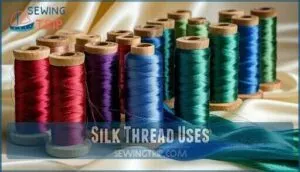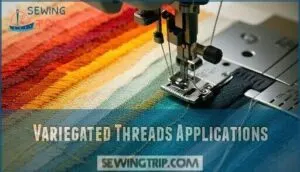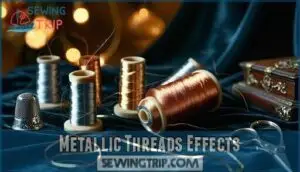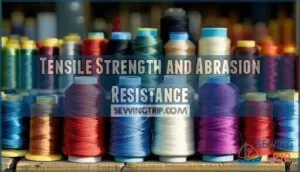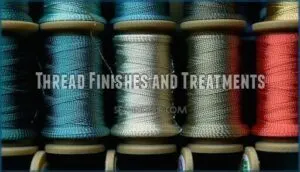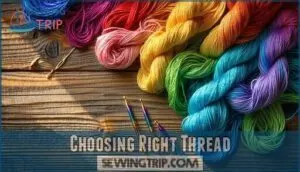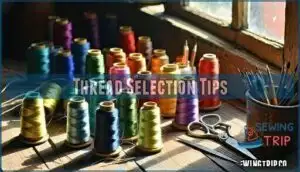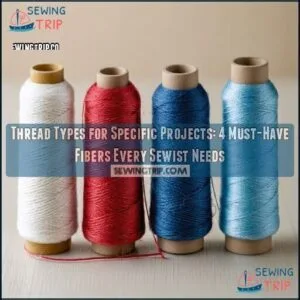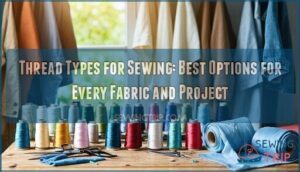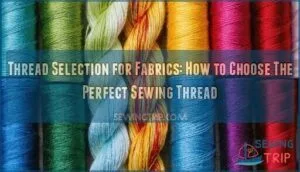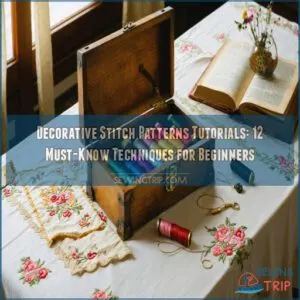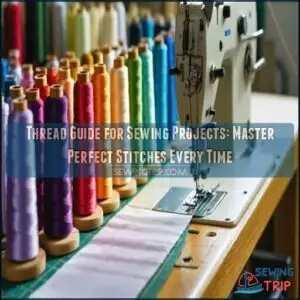This site is supported by our readers. We may earn a commission, at no cost to you, if you purchase through links.
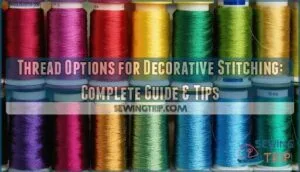 When exploring thread options for decorative stitching, you’ll find several fantastic choices that’ll transform your projects.
When exploring thread options for decorative stitching, you’ll find several fantastic choices that’ll transform your projects.
Cotton threads deliver a classic matte finish that’s perfect for quilting, while rayon threads bring that gorgeous sheen that makes embroidery pop.
Polyester threads are your reliable workhorses—they’re strong, colorfast, and handle most decorative techniques without breaking a sweat.
Metallic threads add serious sparkle but can be finicky, requiring patience and machine adjustments.
Silk threads offer luxurious results, and variegated threads create stunning color shifts that’ll make your stitching look professionally crafted.
Each thread type brings its own personality to your work, from subtle elegance to bold statement pieces.
Table Of Contents
Key Takeaways
- Choose cotton for reliability and rayon for shine – Cotton threads deliver consistent results with a classic matte finish, perfect for quilting, while rayon threads provide a gorgeous sheen that makes your embroidery pop with vibrant colors.
- Match thread weight to your needle size – Use 40wt thread with 90/14 needles for most decorative work, and remember that heavier threads need larger needles and adjusted tension to prevent breakage.
- Consider your fabric type when selecting threads – Match thread content to fabric (cotton with cotton, polyester with synthetics) to prevent shrinkage issues and ensure your decorative stitching maintains its intended look.
- Understand thread properties for project success – Check tensile strength, colorfastness, and special finishes before starting, as these factors determine whether your decorative stitching will survive washing and wear over time.
Thread Types Overview
When you’re planning decorative stitching projects, understanding your thread options makes all the difference between stunning results and frustrating tangles.
You’ll find three main categories to keep in mind: all-purpose threads for versatility, specialized heavy-duty options for durability, and decorative varieties that add visual flair to your work.
All-Purpose Thread Characteristics
When selecting all-purpose thread for decorative stitching, you’ll find three main thread composition options: 100% cotton, 100% polyester, and cotton/polyester fiber blends.
Cotton offers stability but lacks stretch, while polyester provides superior thread durability and cost effectiveness.
Blended thread types combine both benefits, giving you versatile color options for most decorative thread types and thread selection needs.
Specialized Threads for Durability
When all-purpose threads aren’t tough enough for your project, heavy-duty options step up to handle the challenge.
Upholstery threads and specialty options for sports gear deliver the strength you need for demanding applications.
These industrial-strength threads use nylon or polyester construction to withstand outdoor fabrics and topstitching requirements.
Their enhanced durability makes them perfect for heavy-duty sewing projects.
Decorative Threads Properties
When decorative stitching becomes your canvas, thread properties transform ordinary projects into stunning masterpieces.
Understanding these characteristics helps you choose the perfect thread for each creative vision.
Key decorative thread properties include:
- Luster and Sheen – Determines light reflection and visual impact
- Color Variation – Affects pattern complexity and visual interest
- Thread Weight – Controls stitch definition and texture appearance
- Material Composition – Influences drape, durability, and specialty thread textures
For heavier fabrics, consider using heavy-duty thread options to guarantee durability.
Decorative Thread Options
When you’re ready to add visual flair to your sewing projects, decorative threads open up a world of creative possibilities.
These specialized threads transform ordinary stitching into stunning embellishments that catch the eye and elevate your work.
Silk Thread Uses
Silk thread transforms your decorative stitching with unmatched silk sheen and silk durability.
You’ll discover why fine garments and silk embroidery projects benefit from this premium choice.
Silk thread embroidery creates stunning results on delicate fabrics, while its strength supports intricate decorative purposes.
Choose silk thread for embroidery when you want professional results that last.
Silk’s use in embroidery has historical roots in China, dating back to the Neolithic period.
Variegated Threads Applications
Magic happens when variegated thread meets your sewing machine.
This multicolored marvel creates stunning gradient effects and unique textures through natural color shifts.
You’ll achieve beautiful color blending in embroidery projects, while pattern creation becomes effortless as thread colors shift automatically.
Perfect for thread painting techniques and machine embroidery thread applications in decorative stitching. Consider using tone-on-tone colors for blending effects.
Metallic Threads Effects
Adding metallic threads to your decorative stitching projects creates stunning visual impact with their distinctive luster and sparkle.
These specialized embroidery thread options elevate ordinary designs into eye-catching masterpieces through their reflective properties.
Here are three key metallic thread effects to keep in mind:
- Enhanced visibility – Metallic luster catches light beautifully, making your stitching techniques shine under various lighting conditions
- Luxurious appearance – Color combinations with metallics add elegance and sophistication to any project
- Textural depth – Metallic thread creates dimensional contrast against standard thread types
Modern metallic thread options offer improved thread durability compared to earlier versions.
For best results, consider using high-quality thread selection to avoid breakage.
Follow proper care instructions to maintain their brilliance over time.
Thread Properties Importance
When you’re choosing decorative threads, the thread’s physical properties directly impact your project’s success and longevity.
Understanding tensile strength, colorfastness, and special finishes helps you select threads that won’t break, fade, or disappoint after hours of careful stitching, ensuring your project achieves the desired longevity.
Tensile Strength and Abrasion Resistance
Strong threads hold up over time, but weak ones break down fast. Thread durability depends on tensile strength and abrasion resistance—two key factors that determine stitch longevity.
High-quality embroidery thread resists material degradation from friction impact, maintaining weave integrity through countless washes and wear cycles.
| Thread Type | Tensile Strength | Abrasion Resistance | Best Use |
|---|---|---|---|
| Polyester | High | Excellent | General decorative work |
| Cotton | Medium | Good | Natural fabric projects |
| Metallic Thread | Low | Poor | Accent stitching only |
| Rayon | Medium | Fair | Machine embroidery |
The choice of thread type is crucial, as it affects the overall quality and appearance of the embroidery work, with factors such as thread durability and material compatibility playing significant roles.
Colorfastness and Chemical Resistance
Your thread’s colorfastness and chemical resistance determine whether your decorative stitching will survive life’s challenges.
Quality threads resist fading from sunlight exposure and washing effects, while maintaining vibrant thread color through multiple dry cleaning cycles.
Dye stability and bleach resistance protect your investment, ensuring thread durability matches your project’s expectations.
These thread properties separate professional results from disappointment, highlighting the importance of thread durability.
Thread Finishes and Treatments
Beyond color durability, special thread finishes dramatically impact your decorative stitching results.
Mercerization benefits cotton threads with 20% stronger tensile strength and brilliant color absorption.
Glazing effects create smooth, tangle-resistant surfaces perfect for hand quilting but avoid machine use.
Bonding agents enhance abrasion resistance for heavy-duty projects.
Lubricant application reduces friction during high-speed sewing, preventing breaks and heat buildup.
The use of these finishes can significantly improve the overall quality of your stitching, with special thread finishes being a key factor in achieving professional-looking results.
Choosing Right Thread
Selecting the right thread for decorative stitching depends on your fabric type, project goals, and machine capabilities.
You’ll need to take into account thread weight, fiber content, and compatibility with your needle size to achieve professional-looking results.
Fabric Type Consideration
When matching thread to fabric, you’re basically playing matchmaker – the wrong pairing can spell disaster for your decorative stitching projects.
Consider these fabric-specific thread choices:
- Lightweight Fabrics – Use fine cotton or polyester threads
- Heavyweight Fabrics – Choose heavy-duty upholstery threads
- Knit Fabrics – Select polyester for stretch compatibility
- Delicate Fabrics – Opt for silk or fine embroidery floss variety
- Stretch Fabrics – Pick flexible polyester or blended thread types
For delicate projects, consider using specialized fabric thread.
Sewability Factors
Your machine’s performance dramatically affects your decorative stitching success. Thread tension, machine speed, and needle type work together like a well-tuned orchestra.
Too-tight tension snaps delicate threads, while excessive speed creates uneven stitches. Consider these sewability factors:
| Factor | Impact | Solution |
|---|---|---|
| Thread Tension | Controls stitch formation | Adjust for thread types |
| Machine Speed | Affects stitch quality | Reduce for embroidery work |
| Fabric Feed | Maintains smooth movement | Match to quilting needs |
Proper needle selection prevents thread shredding and maintains consistent fabric feed throughout your sewing projects. Achieving superior results often requires careful thread tension adjustment.
Thread Measurement Systems
Understanding thread sizing systems helps you make informed choices for your decorative projects. Different measurement standards can seem confusing at first, but they’re actually straightforward once you know the basics.
Here’s what you need to know about thread measurement systems:
- Tex System – Measures weight in grams per 1,000 meters; higher numbers mean thicker threads
- Denier Explained – Weight in grams per 9,000 meters; commonly used for decorative and industrial threads
- Weight Conversion – Uses inverse numbering where higher numbers indicate finer threads (50wt is thinner than 30wt)
- Metric Equivalents – Measurement Standards help guarantee consistent thread selection across different manufacturers and regions
To guarantee the best results, consider thread weight measurement for your fabric.
Thread Selection Tips
You’ll want to match your thread choice to your fabric type and project needs to prevent shrinkage and maintain proper drape.
Consider thread weight, needle compatibility, and colorfastness when selecting decorative threads for the best stitching results.
Matching Thread Content to Fabric
When fabric and thread fibers match, you’ll prevent fabric shrinkage and guarantee thread durability throughout your project’s life.
Perfect thread-to-fabric matching prevents shrinkage headaches and ensures your decorative stitching stays stunning for years to come.
Smart thread selection creates harmony between materials, improving stitch appearance and project longevity.
| Fabric Type | Best Thread Match |
|---|---|
| Cotton fabrics | Cotton or cotton-blend threads |
| Synthetic blends | Polyester or blended threads |
| Stretch materials | Polyester threads with elasticity |
| Natural fibers | Natural fiber threads for compatibility |
| Mixed compositions | Blending fibers in thread selection |
This fabric compatibility approach guarantees your embroidery and quilting projects maintain their intended look while maximizing thread properties for lasting results.
Needle Size Compatibility
Your needle size directly impacts thread performance and stitch quality.
Use a 90/14 needle for standard 40wt decorative thread, following a needle size chart for ideal matching.
Thread weight guide recommendations prevent skipped stitches and guarantee smooth embroidery.
Fabric thickness impact requires adjusting both thread selection and needle compatibility – thicker fabrics need larger needles to accommodate thread size without breaking.
Selecting the correct needle prevents frequent thread breakage and is crucial for preventing breakage and ensuring ideal matching.
Thread Weight and Thickness Considerations
Most decorative threads range from 12wt (thick) to 60wt (fine), with 40wt being your go-to choice for machine embroidery.
Heavier threads create bold, prominent stitches but need larger needles and adjusted thread tension.
Lighter threads produce delicate details with superior stitch quality, and finer options offer versatility across various sewing machine settings and fabric types.
Remember: thicker threads require more needle compatibility considerations, while finer options offer versatility across various sewing machine settings and fabric types.
Frequently Asked Questions (FAQs)
What kind of thread to use for decorative stitches?
Think decorative stitching demands fancy thread? You’re partly right!
Use rayon thread for vibrant colors and lustrous shine, or polyester for strength and colorfastness.
Metallic threads add sparkle, while 40wt remains your go-to weight for most decorative work.
What type of thread is suitable for decoration?
You’ll want rayon or polyester threads for decorative stitching since they offer vibrant colors and lustrous shine.
Rayon provides smoothness and strength, while polyester delivers durability and colorfastness for lasting decorative effects.
What are decorative threads?
Back when knights wore armor, you’ll find decorative threads are specialty threads designed to add visual appeal to your sewing projects.
They include silk threads with high sheen, metallic threads for sparkle, rayon threads with vibrant colors, and variegated threads with changing hues.
What type of thread should I use for stitching?
Choose polyester or rayon threads for decorative stitching. You’ll get vibrant colors and smooth texture. Match thread weight to your needle size—40wt works best for most projects.
Can decorative threads be used for construction seams?
Don’t let decorative threads become your construction nightmare!
While these gorgeous threads shine in embroidery, they’re typically too delicate for structural seams.
You’ll want sturdy all-purpose or heavy-duty threads for construction work, as they can provide the necessary strength and durability, making heavy-duty threads a good option.
How do I prevent metallic thread from breaking?
Use a lower tension setting, slower stitching speed, and a larger needle size.
Switch to a high-quality metallic thread, verify your machine’s properly threaded, and consider using metallic thread lubricant or conditioner.
What causes thread to bunch up while embroidering?
Think it’s just bad thread?
Thread bunching happens when you’re racing too fast, using wrong needle sizes, or skipping tension adjustments.
Slow down, match your needle to thread weight, and check tension settings, to avoid issues like thread bunching.
Do decorative threads require special bobbin thread?
Most decorative threads work perfectly with regular all-purpose polyester bobbin thread.
You don’t need special bobbin thread unless you’re using extremely thick decorative threads or want specific color effects showing through your fabric.
Which decorative threads work best for stretch fabrics?
Polyester threads account for over 60% of decorative stitching applications, making them your best bet for stretch fabrics.
You’ll want polyester or polyester-blend threads since they stretch with your fabric, preventing broken stitches when the material moves.
Conclusion
Surprisingly, the most successful decorative stitching projects often start with the simplest thread choice.
You’ll discover that mastering thread options for decorative stitching transforms ordinary fabric into stunning artwork.
Cotton provides reliability, rayon delivers shine, and polyester offers durability for everyday use.
Metallic threads create dramatic effects, while silk adds luxury to special projects.
Consider your fabric type, machine capabilities, and desired finish when selecting threads.
With practice, you’ll confidently choose the perfect thread for every decorative stitching adventure to create stunning artwork.
- https://www.superiorthreads.com/education/silk-thread-faq
- https://www.wonderfil.ca/blog/tag/fine+thread
- https://www.threadart.com/collections/rayon-thread
- http://www.createforless.com/Signature-100percent-Cotton-Quilting-Thread-500-yd-Variegated/plid4831.aspx
- http://www.sulky.com/catalog/sub/thread/metallic/holoshimme/

